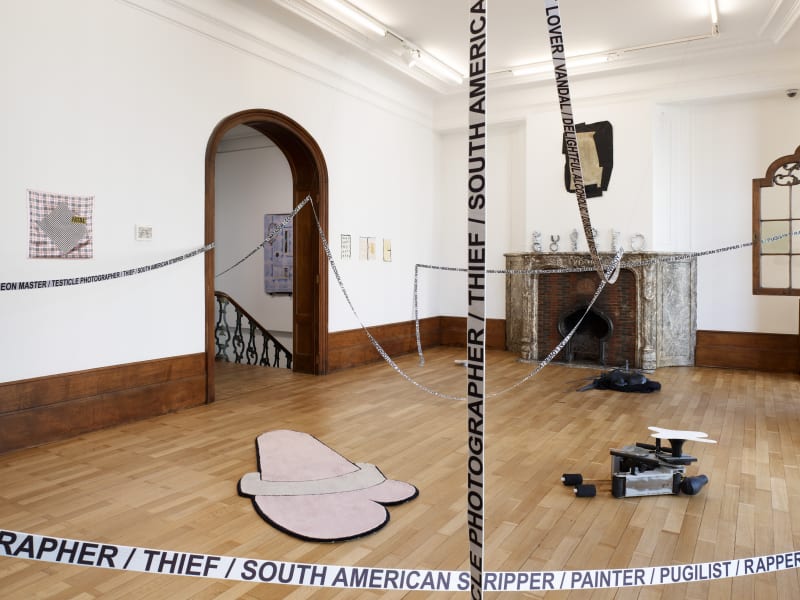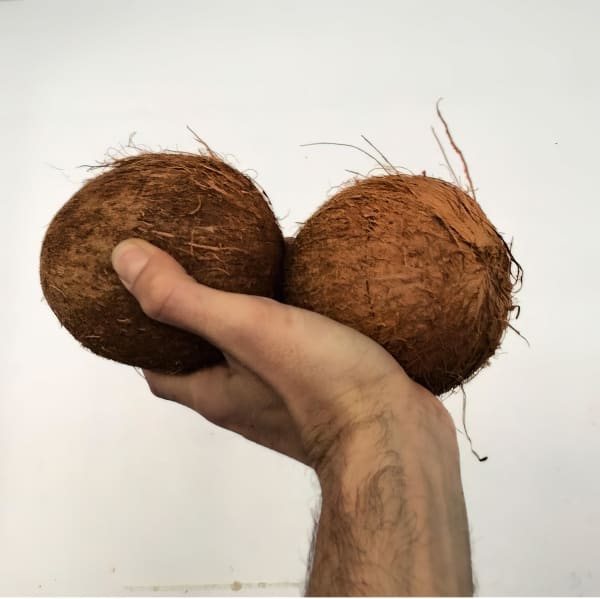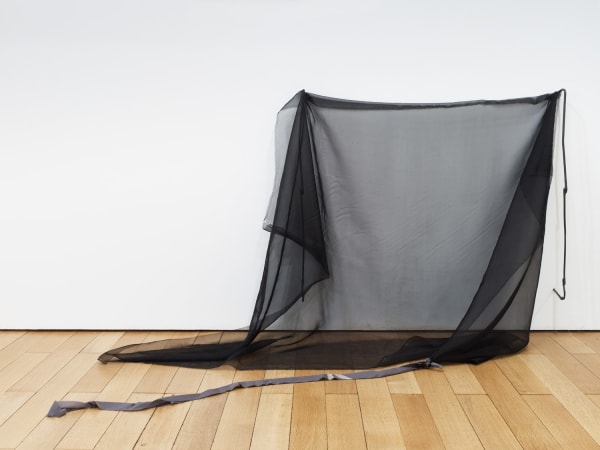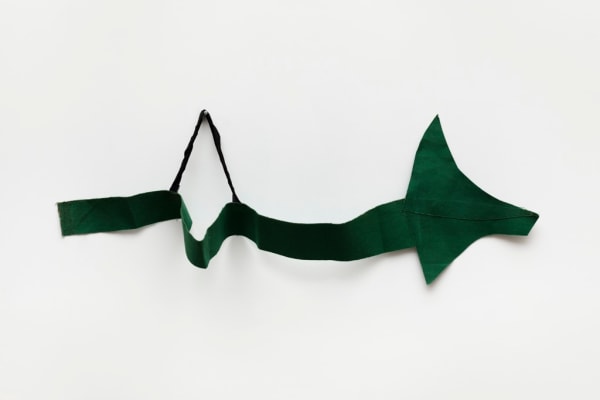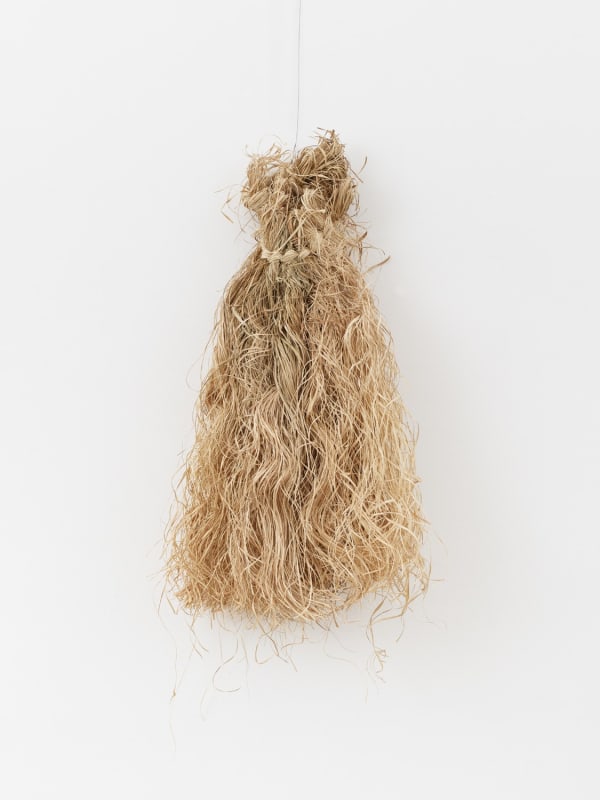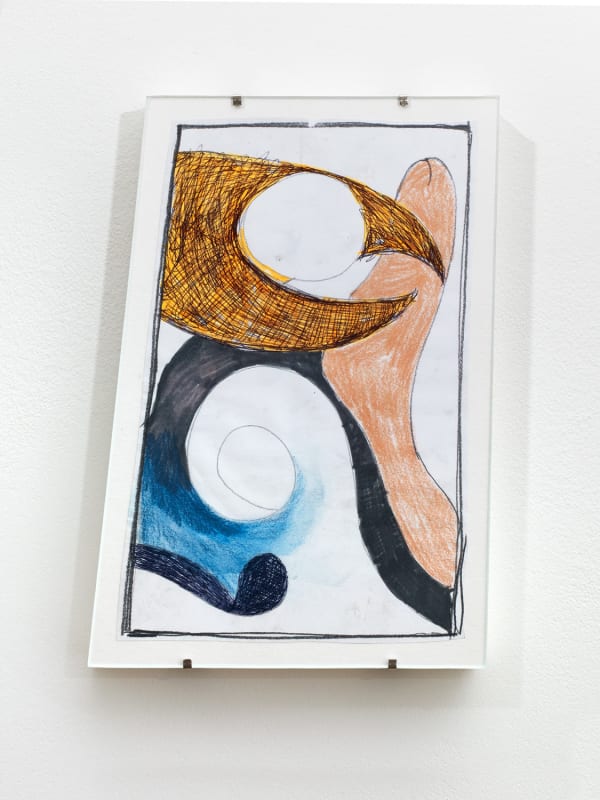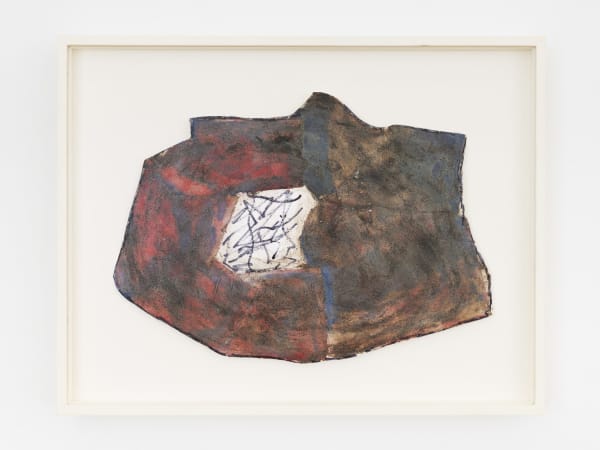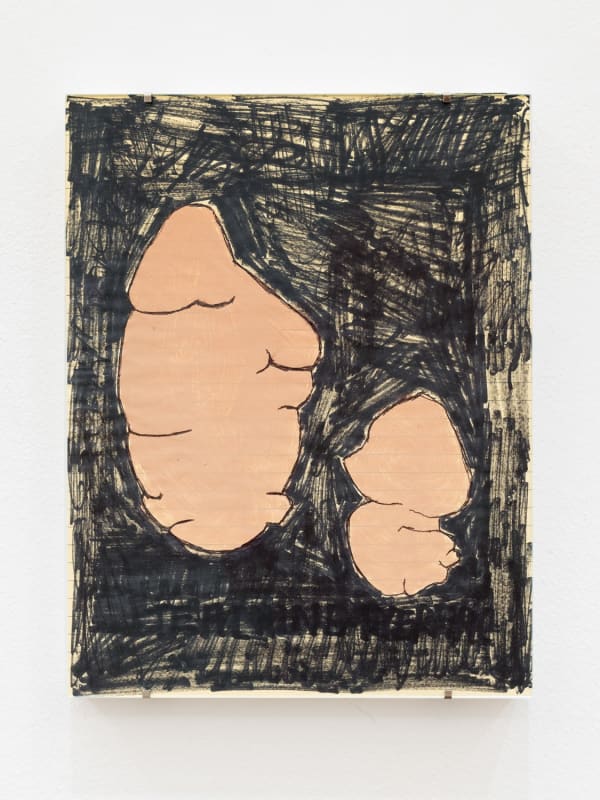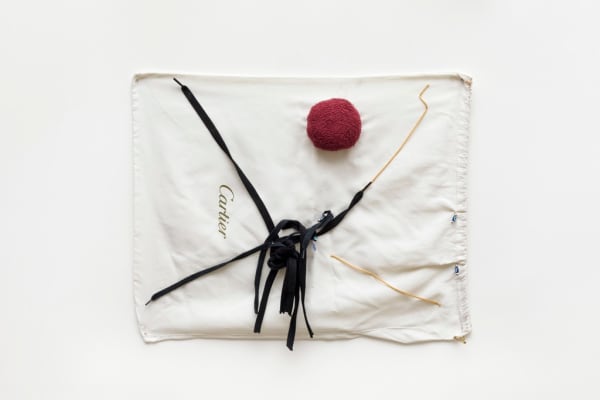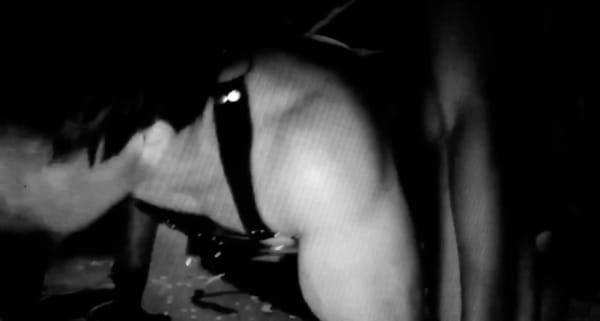Philosophy of the World Adriano Costa
Past exhibition
Overview
Mendes Wood DM is proud to present its first solo show in Brussels by the Brazilian artist Adriano Costa. Comprised of drawing, sculpture and mixed media installations, the exhibition proposes to initiate visitors into the strange and wonderful universe of sign and signification that Costa inhabits – simultaneously outrageous, irreverent and funny, but also deeply moving, poetical and political.
The conceptual springboard for this exhibition is a cult 60s record by The Shaggs titled Philosophy of the World. Self-taught outsiders, the band was made up of three sisters who were reluctantly forced to play music by their father. By conventional standards, their record might be the worst record ever pressed on vinyl. With the sisters barely able to sing or play their instruments, the resulting group of songs is an out-of-time and out-of-tune cacophony. Mysteriously or perhaps miraculously, however, the sound is underpinned by lyrics whose raw, jittery simplicity and apparent childishness reveal strange and unexpected depths of feeling that slowly began to garner appreciation. Rockstar Frank Zappa had their music played on the radio, while legendary music critic and writer Lester Bangs called them “better than the Beatles”.
In many ways Adriano Costa’s work, which also conflates the ridiculous with the sublime, resonates with this bizarre story. He arranges together and transmutes jarring fragments of his own life, his own material and spiritual surroundings, everyday objects, into unexpectedly complex ideas and aesthetic combinations that follow a non-linear logic that is as unique to his own understanding of the world as The Shaggs’ approach to music-making was.
Despite the apparent chaos, the separate works and the show as a whole follow a coherent philosophy of the absurd. “Philosophy is traditionally rational but the works in the show are actually more dada than anything else. They are made from the most mundane and average things translated into sculpture. It’s contaminating high art with the mundane. It’s my own philosophy of the world. The rooms are filled with things that are useless,” the artist says. Indeed, there are machines that don’t work, underwear and bath towels stitched into wall-pieces, Cartier shoe bags stripped of meaning, and meat grinders blessed by South American shamans. “I always ping-pong between references, more than ever in this show,” claims Costa.
His work THE ODDS (2022), a silkscreen curtain emblazoned with the hyper-recognizable Balenciaga-font words “I WILL NOT BE DISAPPOINTED” reverses his approach to the artist-audience relationship. Usually, it is the hope of the audience to not be disappointed by an exhibition, and perhaps the Shaggs knew this when they innocently sang “You can never please anybody in this world.” Costa draws a parallel here: “I’m calling the audience to think with me. It’s like that song by the girls. It’s an invitation. I’m inviting them to my party.”
From the outrageous to the poetical, perhaps the breadth of feeling in Costa’s show can be summed up by two works in the exhibition that somehow bookend this carnival of oppositions. I WATCH TV YOU WATCH TV WE WATCH TV (2021) is a Minimalist-like installation of a single length of elastic band, the kind generally used in men’s underwear. Printed along its entirety is a series of seemingly disconnected words: COWBOY, PET LOVER, RAPPER, TESTICLE PHOTOGRAPHER, DELIGHTFUL ALCOHOLIC. Costa explains: “I was watching an 80s TV show in which one of the characters is asked what kind of ‘fancy activity’ they would like to do. I asked that same question to all my friends who work in the sex industry. Their answers are all on the tape. My favorite one is testicle photographer – it’s a very nice activity.” The humor in this work only temporarily conceals a more serious exercise that sees a marginalized, and certainly not-suitable-for-80s-television crowd, give their own ideas of what an ideal “fancy activity” might be.
VENTO (2022) is a sculpture made of fabric and straw that references Brazilian Orixá mythology. The figure of Obaluaê, a father-divinity within the Candomblé religious tradition, whose face was always hidden behind dense straw and fabric, was responsible for life and death. “Obaluaê was an old man who was shy because his face was full of scars. One day he was swimming in the lake and suddenly a woman called Iansã, the most beautiful woman of the Orixá pantheon, approaches. She looks at him and suddenly sees his true beauty for the first time, and sees behind the mask. If you want to understand beauty you have to unfold it. To understand power, beauty, life and death, you have to unfold it.”
“When I make a show, I put myself in a fragile position, but I am also directing it. I think my work has this. Even when I’m working with metal or clothes etc. I am trying to mold something but at the same time putting all of my fragility in it,” Costa says. “It is definitely a mind-fuck. At least I hope so.”
The conceptual springboard for this exhibition is a cult 60s record by The Shaggs titled Philosophy of the World. Self-taught outsiders, the band was made up of three sisters who were reluctantly forced to play music by their father. By conventional standards, their record might be the worst record ever pressed on vinyl. With the sisters barely able to sing or play their instruments, the resulting group of songs is an out-of-time and out-of-tune cacophony. Mysteriously or perhaps miraculously, however, the sound is underpinned by lyrics whose raw, jittery simplicity and apparent childishness reveal strange and unexpected depths of feeling that slowly began to garner appreciation. Rockstar Frank Zappa had their music played on the radio, while legendary music critic and writer Lester Bangs called them “better than the Beatles”.
In many ways Adriano Costa’s work, which also conflates the ridiculous with the sublime, resonates with this bizarre story. He arranges together and transmutes jarring fragments of his own life, his own material and spiritual surroundings, everyday objects, into unexpectedly complex ideas and aesthetic combinations that follow a non-linear logic that is as unique to his own understanding of the world as The Shaggs’ approach to music-making was.
Despite the apparent chaos, the separate works and the show as a whole follow a coherent philosophy of the absurd. “Philosophy is traditionally rational but the works in the show are actually more dada than anything else. They are made from the most mundane and average things translated into sculpture. It’s contaminating high art with the mundane. It’s my own philosophy of the world. The rooms are filled with things that are useless,” the artist says. Indeed, there are machines that don’t work, underwear and bath towels stitched into wall-pieces, Cartier shoe bags stripped of meaning, and meat grinders blessed by South American shamans. “I always ping-pong between references, more than ever in this show,” claims Costa.
His work THE ODDS (2022), a silkscreen curtain emblazoned with the hyper-recognizable Balenciaga-font words “I WILL NOT BE DISAPPOINTED” reverses his approach to the artist-audience relationship. Usually, it is the hope of the audience to not be disappointed by an exhibition, and perhaps the Shaggs knew this when they innocently sang “You can never please anybody in this world.” Costa draws a parallel here: “I’m calling the audience to think with me. It’s like that song by the girls. It’s an invitation. I’m inviting them to my party.”
From the outrageous to the poetical, perhaps the breadth of feeling in Costa’s show can be summed up by two works in the exhibition that somehow bookend this carnival of oppositions. I WATCH TV YOU WATCH TV WE WATCH TV (2021) is a Minimalist-like installation of a single length of elastic band, the kind generally used in men’s underwear. Printed along its entirety is a series of seemingly disconnected words: COWBOY, PET LOVER, RAPPER, TESTICLE PHOTOGRAPHER, DELIGHTFUL ALCOHOLIC. Costa explains: “I was watching an 80s TV show in which one of the characters is asked what kind of ‘fancy activity’ they would like to do. I asked that same question to all my friends who work in the sex industry. Their answers are all on the tape. My favorite one is testicle photographer – it’s a very nice activity.” The humor in this work only temporarily conceals a more serious exercise that sees a marginalized, and certainly not-suitable-for-80s-television crowd, give their own ideas of what an ideal “fancy activity” might be.
VENTO (2022) is a sculpture made of fabric and straw that references Brazilian Orixá mythology. The figure of Obaluaê, a father-divinity within the Candomblé religious tradition, whose face was always hidden behind dense straw and fabric, was responsible for life and death. “Obaluaê was an old man who was shy because his face was full of scars. One day he was swimming in the lake and suddenly a woman called Iansã, the most beautiful woman of the Orixá pantheon, approaches. She looks at him and suddenly sees his true beauty for the first time, and sees behind the mask. If you want to understand beauty you have to unfold it. To understand power, beauty, life and death, you have to unfold it.”
“When I make a show, I put myself in a fragile position, but I am also directing it. I think my work has this. Even when I’m working with metal or clothes etc. I am trying to mold something but at the same time putting all of my fragility in it,” Costa says. “It is definitely a mind-fuck. At least I hope so.”
Works
-
 Adriano Costa, Coconuts, 2022
Adriano Costa, Coconuts, 2022 -
 Adriano Costa, BlameItOnTheBuggie, from The 3 ugly sisters series, 2017
Adriano Costa, BlameItOnTheBuggie, from The 3 ugly sisters series, 2017 -
 Adriano Costa, Andromède, from The 3 ugly sisters series, 2017
Adriano Costa, Andromède, from The 3 ugly sisters series, 2017 -
 Adriano Costa, Tidal Dynamics - I love u more, 2014
Adriano Costa, Tidal Dynamics - I love u more, 2014 -
 Adriano Costa, I WATCH TV YOU WATCH TV WE WATCH TV, 2021
Adriano Costa, I WATCH TV YOU WATCH TV WE WATCH TV, 2021 -
 Adriano Costa, PEDRO, PRINCE , 2021
Adriano Costa, PEDRO, PRINCE , 2021 -
 Adriano Costa, IT'S A BOY, 2022
Adriano Costa, IT'S A BOY, 2022 -
 Adriano Costa, Sócrates - Timão, 2018
Adriano Costa, Sócrates - Timão, 2018 -
 Adriano Costa, Window Socks, 2022
Adriano Costa, Window Socks, 2022 -
 Adriano Costa, BEYOND ANGEL AND EVIL- POP SHADE, 2021
Adriano Costa, BEYOND ANGEL AND EVIL- POP SHADE, 2021 -
 Adriano Costa, SIAMESE SISTERS, 2021-2022
Adriano Costa, SIAMESE SISTERS, 2021-2022 -
 Adriano Costa, CHINESE DRAGON, 2022
Adriano Costa, CHINESE DRAGON, 2022 -
 Adriano Costa, PIERROT, 2022
Adriano Costa, PIERROT, 2022 -
 Adriano Costa, Noses, 2019
Adriano Costa, Noses, 2019 -
 Adriano Costa, RRÁDIO COCONUTS - 1 e 2, 2022
Adriano Costa, RRÁDIO COCONUTS - 1 e 2, 2022 -
 Adriano Costa, THE ODDS, 2022
Adriano Costa, THE ODDS, 2022 -
 Adriano Costa, I wanna fuck with common people like u, 2022
Adriano Costa, I wanna fuck with common people like u, 2022 -
 Adriano Costa, Table, 2018
Adriano Costa, Table, 2018 -
 Adriano Costa, VENTO, 2022
Adriano Costa, VENTO, 2022 -
 Adriano Costa, Paris, 2015
Adriano Costa, Paris, 2015 -
 Adriano Costa, TUXEDO, 2021
Adriano Costa, TUXEDO, 2021 -
 Adriano Costa, BANANA BOAT, 2021
Adriano Costa, BANANA BOAT, 2021 -
 Adriano Costa, BROCCOLI MAN , 2022
Adriano Costa, BROCCOLI MAN , 2022 -
 Adriano Costa, SUNSET, 2021
Adriano Costa, SUNSET, 2021 -
 Adriano Costa, CARNAVAL, 2022
Adriano Costa, CARNAVAL, 2022 -
 Adriano Costa, RETRATO, 2021
Adriano Costa, RETRATO, 2021 -
 Adriano Costa, SLUM WON, 2021
Adriano Costa, SLUM WON, 2021 -
 Adriano Costa, Couple, 2022
Adriano Costa, Couple, 2022 -
 Seulgi Lee, U: To cut water with a knife. = A useless quarrel since they are reconciled right away (in a couple), 2017
Seulgi Lee, U: To cut water with a knife. = A useless quarrel since they are reconciled right away (in a couple), 2017 -
 Adriano Costa, Fingerprints, The Neighbor, Suicide Tendencies (from the Fruits series), 2014
Adriano Costa, Fingerprints, The Neighbor, Suicide Tendencies (from the Fruits series), 2014 -
 Adriano Costa, Maps, 2016
Adriano Costa, Maps, 2016 -
 Adriano Costa, I wanna live with common people like you, 2014–2022
Adriano Costa, I wanna live with common people like you, 2014–2022 -
 Adriano Costa, DOG-GOD, 2022
Adriano Costa, DOG-GOD, 2022 -
 Adriano Costa, Mortuus Museum - São Paulo, 2018-2022
Adriano Costa, Mortuus Museum - São Paulo, 2018-2022 -
 Adriano Costa, Motivational bitches unite, 2018
Adriano Costa, Motivational bitches unite, 2018 -
 Adriano Costa, MUSEU MONDIAL , 2022
Adriano Costa, MUSEU MONDIAL , 2022 -
 Adriano Costa, CLEOPATRA, 2022
Adriano Costa, CLEOPATRA, 2022 -
 Adriano Costa, STAR, 2021
Adriano Costa, STAR, 2021 -
 Adriano Costa, T., 2021
Adriano Costa, T., 2021 -
 Adriano Costa, SurrealisticPenis, 2016
Adriano Costa, SurrealisticPenis, 2016 -
 Adriano Costa, Sun, 2022
Adriano Costa, Sun, 2022 -
 Adriano Costa, TheLesson, 2016
Adriano Costa, TheLesson, 2016 -
 Adriano Costa, Flying Esophagus, 2022
Adriano Costa, Flying Esophagus, 2022 -
 Adriano Costa, Nose, 2016
Adriano Costa, Nose, 2016 -
 Adriano Costa, Landscape - Red Sun, 2022
Adriano Costa, Landscape - Red Sun, 2022 -
 Adriano Costa, COPACABANA GIRL , 2022
Adriano Costa, COPACABANA GIRL , 2022 -
 Adriano Costa, LOVE-FATE, 2022
Adriano Costa, LOVE-FATE, 2022 -
 Adriano Costa, HierarchyKillingTheDream, 2016
Adriano Costa, HierarchyKillingTheDream, 2016 -
 Adriano Costa, ROCKET, 2022
Adriano Costa, ROCKET, 2022 -
 Adriano Costa, PHANTOM PAIN, 2022
Adriano Costa, PHANTOM PAIN, 2022 -
 Adriano Costa, Phantasmagoria, 2022
Adriano Costa, Phantasmagoria, 2022
Installation Views
